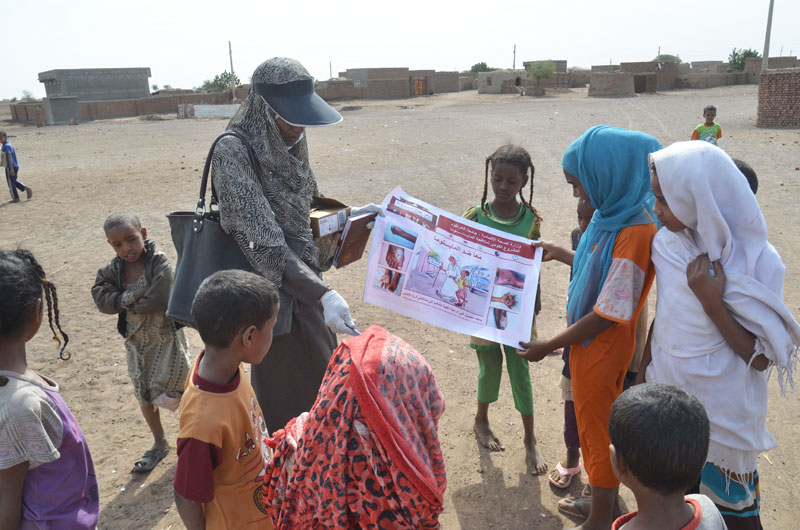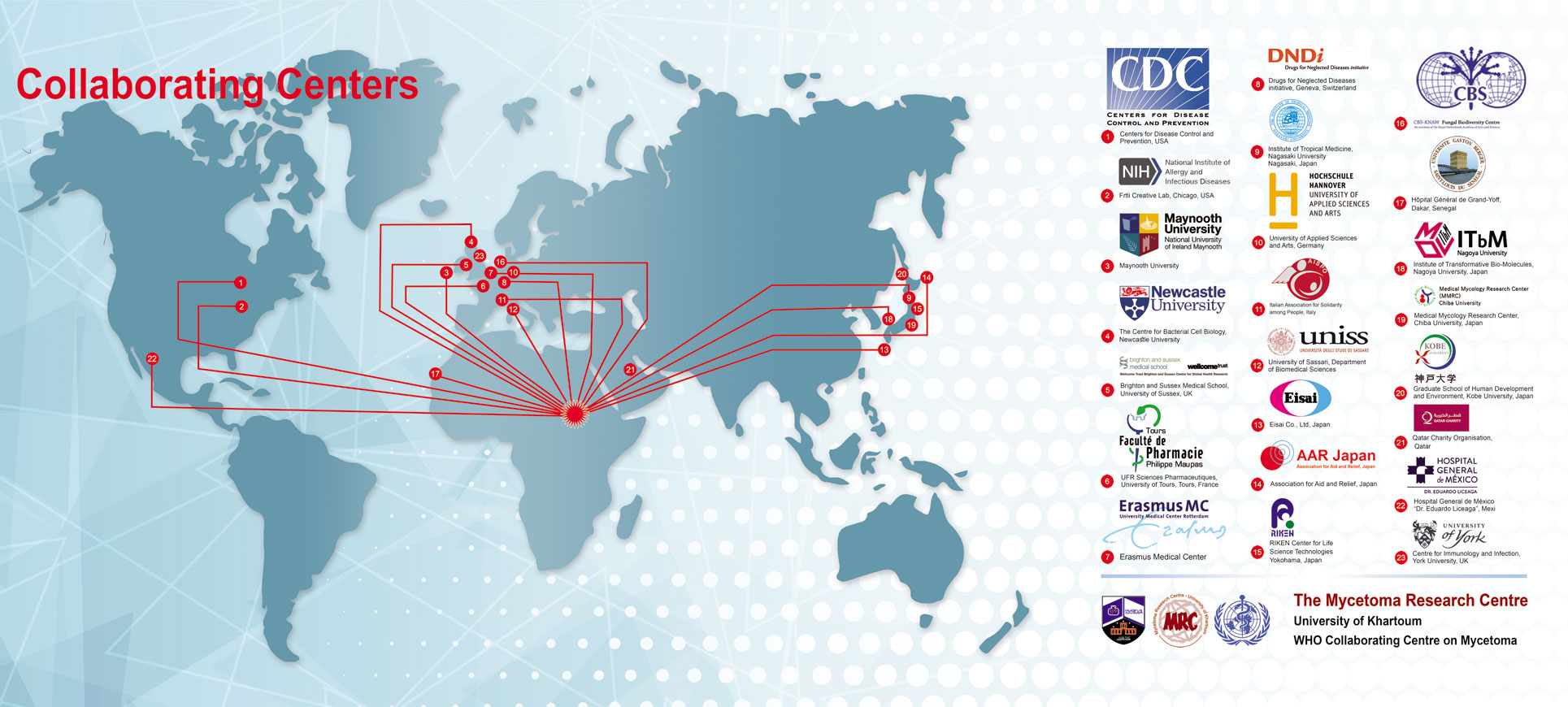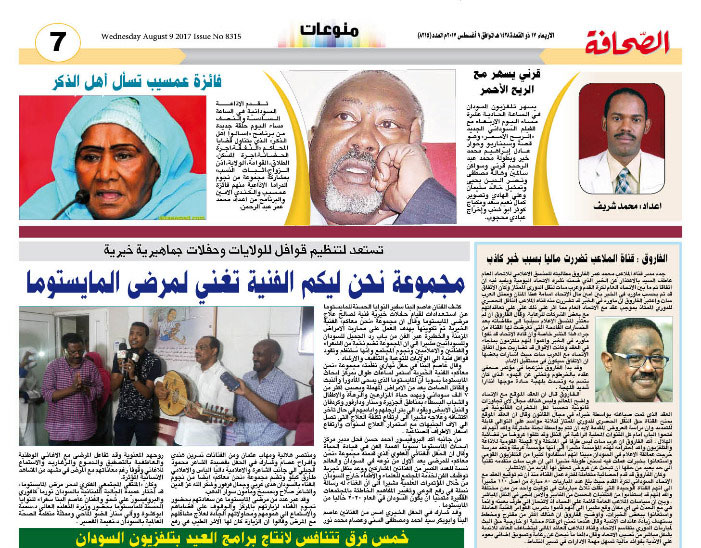The Mycetoma Research Centre Panorama
 1991-2024 | 33 years of Excellence and Leadership
1991-2024 | 33 years of Excellence and Leadership
Patients Management
The Mycetoma Research Centre had established the Mycetoma Clinic and excellent laboratory and imaging diagnostics facilities. That had led to the diagnosis and management of more than 9500 mycetoma patients from Sudan and overseas. The gained experience from this had led to the development of a guideline for mycetoma patients’ management.

Two mycetoma satellite centres at endemic villages, Sennar and White Nile states, Sudan, were established. That tremendously led to the holistic management of more than 1000 patients at rural mycetoma endemic villages free of charge. These had improved patients’ quality of care, early case detection and management, and more patients with small early lesion were managed with good treatment outcome.
Research & Development
El Hassan Centre for Neglected Tropical Disease Clinical Trials was established in 2017 with excellent facilities for clinical trials. It is hosting the first-ever Proof-of-Concept Superiority Trial of Fosravuconazole Versus Itraconazole for Eumycetoma in Sudan, and the trial is about to be completed
The Mycetoma Research & Development Arcade for Continuing professional development training activities was established at the MRC. It had organised many events for staff capacity building.

Joint Research Projects
The MRC is currently collaborating with many centres and institutions, and these include:
Erasmus Medical Centre, Rotterdam University.
Sussex University, UK.
Tours University, France.
York University, UK.
RIKEN Center for Integrative Medical Sciences Japan.
Nagasaki University, Japan
Establishment of Post-Graduate Programme
Outcomes:
Improved staff capacity building
More than 300 publications in high impact factors journals.
Special issue on Mycetoma at Transactions of the Royal Society of Tropical Medicine and Hygiene.
Mycetoma special collection, PLoS Neglected Tropical Diseases Journal.
Ten PhD students based at the MRC and registered at Sussex, Rotterdam, Tours Universities
Two Postdoctoral students
Teaching:
Collaboration with International Research Centres and NGOs
The MRC currently is collaborating with 23 international research centres and NGOs. That led to infrastructure and staff cavity building development, and many research projects were conducted.
https://www.rstmh.org/news-blog/blog/mycetoma-%E2%80%9Ca-scar-on-the-human-conscience%E2%80%9D
Community Engagement
Many activities were conducted, and that include:
The Mycetoma Cultural Week was organised in collaboration with The French Institute and the French Embassy in Khartoum in the period 23rd – 27th February 2020. The week included paints and fine art exhibition, comedy shows and presentations. More than 70 paints and fine art collections on mycetoma awareness were produced.

A three-day training workshop on Mycetoma Health Promotion, Advocacy and Awareness for Media Professionals was conducted in the period 2nd and 4th January 2021. It was organised in collaboration with Hope International Organisation. Twenty participants from different media specialists included comedians, journalists, radio and TV commentators, newspaper writers, poets, actors, fine artists, film editors and producers, public relations specialists, bloggers, sound engineers, and art directors, had attended the workshop. It had improved the mycetoma awareness and advocacy among the media specialists. More news press, radio and TV interviews on mycetoma were produced.

The Visual documentation of Mycetoma in Sudan Workshop was organised in collaboration with the Ceramic Department of the College of Fine and Applied Arts, the University of Sudan, in the 13th-22nd March 2012. Fifteen members of the Ceramic Department had attended the workshop. They produced 47 ceramic and fine art collections on mycetoma advocacy.
![]() The establishment of the We Are With You Group.
The establishment of the We Are With You Group.
This is a group of the top 40 celebrities, fine artists, singers, comedians, and journalists in Sudan working together to support mycetoma patients, the MRC and the Mycetoma Friends Association to execute their activities to improve the patients’ quality of life. The group had organised several events, and one of them was a trip to mycetoma endemic regions in central Sudan and ended a Gala Night at Sennar Town attended by a massive crowd 16 they produced many short video clip messages that led to more awareness and advocacy

The establishment of The Mycetoma Friend Association. It was established at the MRC in 2008 to help mycetoma patients, especially those with low socio-economic status, by providing the necessary medical, financial and psychological care and support. The Association had supported many mycetoma patients medical and health care, offered socio-economic support for the needed patients and provided many limb prostheses, investigations and medicines for the needed patients. It conducted many field activities that led to more early case detection and management.
Out-Reach Community Activities
The Mycetoma Vocational and Entrepreneurship Training Centre (SAA’ID) establishment. It is a hub for vocational training, business development, and entertainment, located at the MRC. It aims to create an enabling environment for the mycetoma amputees and disabled persons to learn and develop income-generating skills, perform and upgrade their talents, and be prepared to lead a new life of being productive, self-reliant and confident. SAA’ID has various vocational training programmes such as Sudanese handcraft and leather industry, artisan-work, painting, graphics, woodwork, etc. Furthermore, it qualifies trainees on business development skills to become professional entrepreneurs and ready to establish small developing enterprises. Various vocational and entrepreneur trainings were conducted.

The Limb Prosthesis Campaign
The Mycetoma Research Centre, in collaboration with the Sennar State Ministry of Health and EL Zaka Fund, had organised a mission to offer prosthesis for the mycetoma amputees free of charge at their villages by mobilising a mobile workshop to Wad Onsa Mycetoma Satellite Centre. 160 prostheses were done at the village and given free of charge. That had saved the amputees and their families the trouble and cost of the travel, accommodation at Khartoum, the time and cost.

Community Environmental Improvement Campaigns. The MRC, in collaboration with the Sennar State Government, official local authorities, community leaders and activists, and Red Crescent volunteers, organised several campaigns to improve Wad El Nimear village environment, sanitation, and hygiene to reduce the mycetoma transmission risk factors such as thorns, sharp objects, animals dungs. During these campaigns, the thorny trees and bushes, thorny animals’ enclosure, animals dungs, dirt and rubbish were removed and burnt.

The Animals’ Enclosure Project
Seventy-two modern animal enclosures were constructed outside Wad EL Nimear village. This was done to improve the village hygiene, reduce contact with the animals and their excreta, and eradicate the thorny cages. This project was conducted by a kind donation from an engineering company as part of its social reasonability activity. These new animals’ cages were distributed free of charge to the villagers.
Shoe Distribution at The Endemic Regions
The MRC distributed around 800 news shoes to the school pupils at mycetoma endemic villages in Sennar State to improve personal hygiene and to reduce the risk of developing mycetoma.
Early Case Detection, Management, Awareness and Advocacy Campaigns
The MRC teams conducted house to house surveys in all eastern Sennar locality for early cases detection. Suspected cases were referred to Wad Onsa Mycetoma satellite centre for management. 73 Village were surveyed, 12181 households were screened, and 973 suspected cases detected and managed. Different health education events were conducted during these campaigns, and that included: house-house interviews, open theatre, presentations, meetings and focal group discussions. That resulted in more mycetoma awareness, and advocacy, early case detection, more patients with small early lesion were managed, improved local villages hygiene and environment.
Awareness And Advocacy
The MRC had actively utilised social media to execute its activities, and that included: Facebook – Twitter – YouTube – Instagram
More than 180 short video clips and messages on mycetoma awareness and advocacy were produced and posted on different social media.
National and International Radio and Television Events
Press Communication
Many local and international newspapers and newsagents had conducted interviews and documentaries on mycetoma and the National and international mycetoma awareness improved
Community Involvement in Endemic Villages
 Local community activities at the villages mosques, schools, health centres and others were conducted. More mycetoma awareness and advocacy, early case detection and improved local villages hygiene and environment were achieved.
Local community activities at the villages mosques, schools, health centres and others were conducted. More mycetoma awareness and advocacy, early case detection and improved local villages hygiene and environment were achieved.
The Mycetoma Ambassadors
The MRC every year select some community activists, professionals, celebrities as Mycetoma ambassadors who assist the MRC to execute its objectives and activities.
Teaching And Learning
Conferences and Seminars Organisation
- The MRC had organised the following international conferences
- The Third Mycetoma International Conference, Khartoum, 2002
- The Fifth Mycetoma International Conference, Khartoum, 2011
- The Sixth Mycetoma International Conference, Khartoum, 2019
- The Mycetoma International Seminar, Khartoum, 2009
- The Mycetoma International Training Workshop, Khartoum, 2019
- teaching

Distant Learning Activity
The MRC has an online mycetoma learning module for medical and health professionals and students for capacity building.
STTalks Series
The MRC contributed to this series to improve mycetoma awareness and advocacy.
International Collaboration
The Mycetoma Global Working Group
The MRC had contributed to the establishment of The Mycetoma Global Working Group. This group consists of more than 70 mycetoma experts from 35 countries globally with the aim to improve mycetoma patients’ quality of care and research worldwide.

Collaboration with International Research Centres and NGOs
The MRC currently is collaborating with 25 international research centres and NGOs. That had led to infrastructure and staff cavity building development, and many research projects were conducted.
MRC At The WHO
MRC as a WHO Collaborating Centre on Mycetoma

The MRC was designed as a WHO Collaborating Centre on mycetoma in 2015 and was redesigned in 2019. The Terms of Reference with the WHO are:
To elucidate the epidemiology of Mycetoma
To improve management of cases of mycetoma
To disseminate information about mycetoma and build capacity of health care providers
WHO Collaborating Center
The Mycetoma Research Centre, University of Khartoum, WHO Collaborating Centre on Mycetoma
The Mycetoma Research Centre, University of Khartoum was designated as the only WHO Collaborating Centre on Mycetoma in 2015 with specific Terms of Reference and these are:
To elucidate epidemiology of Mycetoma
To improve management of cases of mycetoma
To disseminate information about mycetoma and build capacity of health care providers
Membership at NTDs/WHO Committees
MRC staff sits on different WHO/NTDs committees and subcommittees.
Mycetoma Resolution No. WHA69:21
MRC submitted a submission to include mycetoma as an NTD in 2016 through the Sudan Ministry of Health, and eventual that was accepted and Mycetoma now a member of the WHO/NTDs priority list.
The Khartoum Call for action

MRC drafted the Khartoum Call for Action during the Sixth International Conference on Mycetoma in 2019 at Khartoum, Sudan, which was endorsed by the WHO and other international organisations and NGOs.
WHO Senior Officials Visits to The MRC
Many seniors WHO officials had visited the MRC, and that included:
- Dr Tedros Adhanom, WHO Director-General
- Dr Ahmed Al-Mandhari, Regional Director for the Eastern Mediterranean
- Dr Soumya Swaminathan, Senior Scientist, WHO
- Dr Mwelecele Ntuli Malecela, Director of the Department of Control of Neglected Tropical Diseases, WHO

 The establishment of the
The establishment of the 